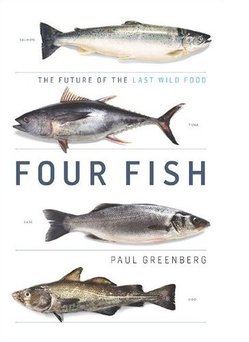

Paul Greenberg, in Seattle (and "glad to be back in salmon country") when his book was published last summer. A paperback edition will be out at the end of May.
Paul Greenberg began his career teaching journalism in post-Soviet Russia, a country that had no tradition of a free press. When he returned to the US and began researching and writing in earnest, he did a piece for the Boston Globe about fish, which led to another piece for the New York Times, which earned an award from the International Association of Culinary Professionals. He turned his new specialty into a fine, fine book, and just this week received the prestigious James Beard award in the category of "Writing and Literature" category for that challenging look at the way we consume the ocean's resources, Four Fish: the Future of the Last Wild Food.
The four are salmon, cod, bass and tuna. All pretty big, as fish go. And they dominate the American fish market.
"Imagine hunting big wild animals," he said to an audience at the UW Bookstore in Seattle this summer, tracking them down across field and through forest to kill and eat them. How long did the continent's herds of wild buffalo last? Turkeys?
We humans have developed a preference for big beasts. American humans, at least, prefer beef to bunnies, even though rabbits, easy to raise and a fine source of protein, are devoured by families across the globe.
We stupidly squander resources, as if eating sirloin strip were a birthright. Yet we're squeamish about songbirds, and each generation has a different notion of what "nature's bounty" means. Big fish, like the bluefin tuna, for instance, are disappearing.
Are we, is the planet, running out of fish? Hardly. The annual catch is on the order of 90 million tons, the human weight of China. (Is that a lot? Yeah.) But the abundance is decreasing, not increasing.
Which brings us to the conundrum. Tuna and salmon are the more fashionable red or pink fish; cod, tilapia and pollock are white. But farmed Atlantic salmon--our most "domesticated" seafood--is white. To make it marketable, growers literally add color. (Many species of white fish are also farmed these days; branzino, loup de mer, sea bass, daurade, sea bream, orata.) Israel has been in the vanguard, farming fully half its fish since the 1950s. And why should farming be all that bad? We farm game, don't we?
Fine, we'll farm fish, but how do we feed them? What will the live bass eat? The answer (drumroll, please) is artemia, a teensy organism that grows only in (wait for it) the Great Salt Lake. You remember those comic book ads for Sea Monkeys? Yup, artemia. (Senator Reid, this is your moment.)
The New York Times recently suggested that tilapia might be the fish of the future. I asked Greenberg, and could almost see him roll his eyes. "It's already in the top three," he wrote to me in an email last week. "Good if grown in close quarters (what's known as 'containment aquaculture') because they grow so fast, bad when grown in lakes. Good as a source of protein for poor communities in the developing world because they can live on anything (if you don't mind the muddy taste when they eat algae). Nutritionally, better than most mammal or birds because it's low in fat."
Greenberg's personal favorite: arctic char. They look like trout or salmon, sleek and silvery with pink flesh. They survive in crowded conditions; in the wild, they feed on abundant shrimp and krill; in closed systems, they simply squeeze together. A situation known to anyone who's ever been in the military: "I want to see the man in front of you smile."
Four Fish will be out in paperback at the end of the month, and Greenberg is returning to Seattle as part of his nationwide book tour.
UPDATE: Indirectly related to Greenberg's book, this news about genetically engineered salmon.
Leave a comment